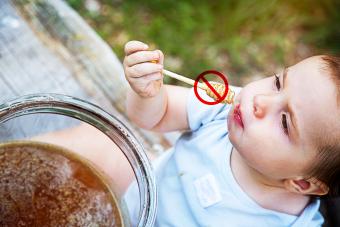
A new parent could easily be overwhelmed by the variety of classes, books, kits, DVDs, personal coaches and websites that teach how to do infant massage. While these tools can certainly be helpful, the irony of the sheer volume of these instructional materials is that basic infant massage consists of a few simple, easily learned, physical guidelines and techniques.
Before You Begin Infant Massage
Once you've decided you want infant massage to be a part of your parenting routine, set some time aside to introduce the process gradually. Although ideally you would massage your baby at the same time every day, in practice babies are rather unpredictable. It's more important that your baby is in the correct mood for the massage than it is that you stick to a timetable.
Assess Your Baby's State
The ideal time to perform an infant massage is when your baby is in a quiet alert state. Many babies are in this state immediately after a short nap. Babies in a quiet alert state are generally attentive to human voices, follow faces, and make smooth, relatively coordinated movements. If your baby is sick, has a fever, or has just received immunizations, it's wise to wait until another day.
Plan the Right Place
The ideal place for infant massage is any relatively quiet, comfortably warm room. Many adults find that soft music enhances their relaxation response during a massage, but this is not true for most infants. It's better to have all electronic noise-makers, from cell phones to stereos, on mute. The TV especially should be not just silenced but turned off. Even without the sound, reality TV antics can be distracting to humans of all ages!
Many parents find it's easiest to massage their baby on the kitchen table. This is a perfectly reasonable solution as long as the table is well padded and you always have at least one hand on your baby to prevent falls. A changing table can work as well, if you have a stool that can enable you to sit comfortably and reach the baby without straining. Some parents massage their baby on their lap, although this requires a not very wiggly baby and excellent hand-eye coordination. Another alternative is to sit on your bed, legs apart with baby in between. This is a very safe option and relaxing - some new parents might even struggle not to fall asleep. However, parents who are trying to maintain a strict no co-sleeping policy, might want to avoid this set-up as it could prove confusing to the baby as they become more aware of their surroundings.
Learning How to Do Infant Massage
Once you've figured out where and when you will be massaging your infant, you're ready to learn the mechanics of infant massage. The mechanics are fairly simple, if you approach the learning in steps.
Assemble Your Supplies
Part of the beauty of infant massage is that -unlike most endeavors involving babies which invariably require enough equipment to warrant the services of a Sherpa - very little in terms of equipment is required. You'll need a comfortable place to sit as described above, a soft blanket to cover the parts of your baby that you're not massaging and a small amount of an appropriate oil.
You use oil in the massage process to cut down on skin-to-skin friction; therefore, many different types of oil can work. Natural oils like almond, sesame seed or even very light olive oil are best. The most important consideration is that the oil is non toxic, since babies may try to lick or taste it. Stay away from scented oils, since they can be irritating to sensitive skin.
Mastering the Strokes
The part most parents are concerned about while learning how to do infant massage is the actual technique for the strokes, but as long as you're following your baby's cues, the whole process is fairly natural. The easiest way to start the massage is with the infant lying on her back so you can make and hold eye contact. Spend a few minutes talking with the baby before you begin, and then follow your baby's lead. If your baby lifts up a leg, start with the leg; if he lifts up his arm, start with that arm. Massage with gentle light strokes. You'll be able to tell by your baby's reaction how much pressure to use. If the touch is too light, you'll know because your baby will become squirmy very quickly, since that type of touch feels almost like tickling.
In general, you'll want to massage from the middle of the body outward, for example, from the shoulder to the elbow and then the elbow to the hand. However, if your baby resists or offers another body part, follow his lead. You can massage your baby's head very gently (avoiding the soft spot, of course) but forgo the oil there as it will make a mess of their hair.
Reading Your Baby's Cues
Each baby has a different tolerance for touch and stimulation and no doubt you can tell when your baby is reaching their limits. Even if you haven't finished massaging every limb, cut the massage short if your baby starts exhibiting any potent disengagement cues, such a refusing eye contact, back arching, spitting up or turning red.
Infant massage is an excellent way to help your baby relax and can promote a healthy immune system, better circulation and better digestion. Perhaps more importantly, learning to massage your infant can build confidence in your parenting skills and your ability to read and understand your baby's cues.







